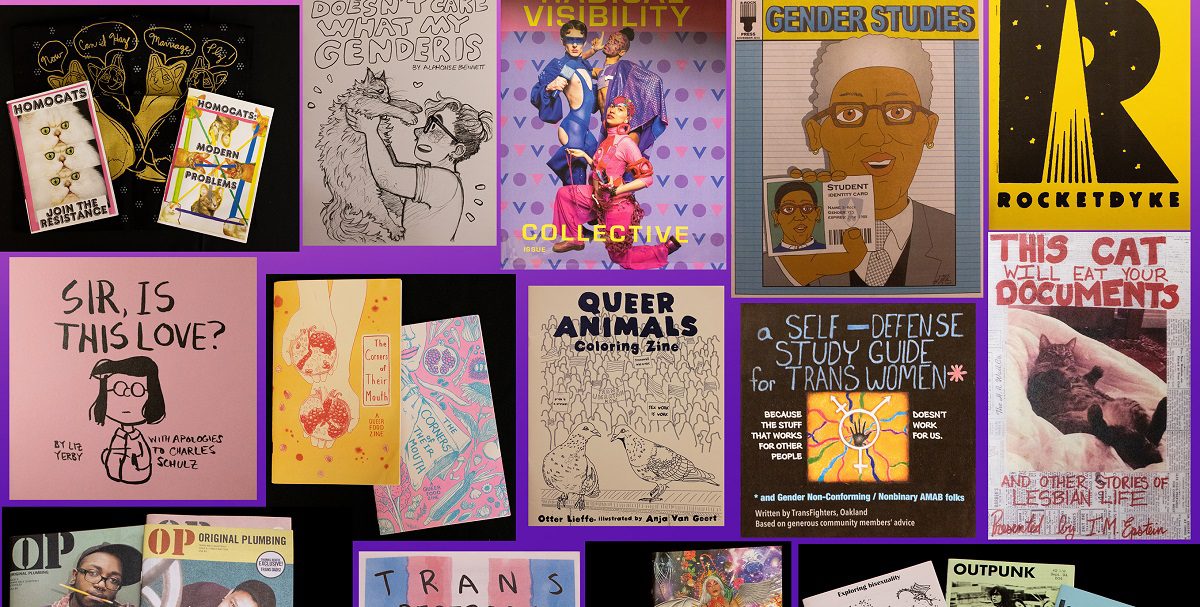HOMOCATS and other queer zines

HOMOCATS, Rocketdyke, Queer Animals, Outpunk – these are just some of the titles you’ll run across in the James B. Duke Library’s latest exhibition in Special Collections and Archives, “Queer Zines at Furman: Highlights from the New LGBTQ+ Zine and Small Press Collection.” On display through December, the exhibition represents a tiny portion of the entire collection comprising more than 500 items, including zines and other small press documents, stickers, totes and T-shirts.

Jeffrey Makala
What is a zine? The Bindery says a zine is “a glorious mash-up of art, letters, story and emotion.” Think of it as a no-rules-apply, easily reproducible, DIY or small press publication whose audience is a niche group or community. The producers of zines want to get their message out quickly, cheaply, and often, under the radar.
Jeffrey Makala, associate director for Special Collections and Archives, says the collection is generating a buzz across campus. And that’s the point.
Acquired in 2019 as part of an effort to expand offerings related to Women’s Gender and Sexuality Studies and overall women’s movement materials, the zine archive has been tapped by professors such as Tuğçe Kayaal (history) and Judith Williams (anthropology) for use in classroom assignments, in particular, for crafting zines.
Covering a range of creative expression and voices, the collection offers examples representing five continents, about a dozen languages and “basically every intersectional part of the LGBTQ spectrum – politics, identity, culture, food and everything else under the sun,” Makala said.
Makala believes the zine format is a great way for professors to introduce something other than a semester-end paper – an “un-essay” or “alternative essay.”
“Faculty members are trying to engage their students by having them create other things – so it could be zines, video productions, video essays, illustrative talks – things that are more engaging and public-facing than an academic paper where one person reads it, then it just goes away,” he said.

Tuğçe Kayaal
Kayaal, an assistant professor of history who joined the faculty in 2021, brought her students to Special Collections in Spring 2022 to help them think about an alternative project in HST-254 Gender and Sexuality in the Middle East.
Two groups of students in the upper-level course created zines and had the opportunity to present their work to a larger audience in a poster session at Furman Engaged, a day set aside at the university to showcase undergraduate research, performing and visuals arts, and other creative works.
“The whole archive truly inspired them,” said Kayaal, who specializes in the history of childhood and youth sexuality in the Middle East. “But the most important thing for me was they really started to think about what it meant to be a queer individual or an LGBTQIA+ individual somewhere else – not just in the Western localities.”
She said the archive is important for expanding our understanding of pivotal historical moments, but it is equally meaningful in other ways at Furman.
“Students do not only learn from their professors, but they also learn from each other and through the resources available on campus,” she said. “The existence of this collection on its own it a big step toward increasing the presence of LGBTQIA+ students on campus – it represents a safe place for having conversations about different sexual orientation and ways students identify. I believe the zine collection both now and in the future will cultivate a stronger sense of belonging for LGBTQIA+ students at Furman.”
Makala, too, is pleased with the inclusivity the archive promotes, as well as the traction it is gaining for scholarly work. But he hopes the collection will simply win the hearts of the curious.
“It’s so rich, full and colorful,” he said. “There’s this wonderful, sly and sarcastic humor punctuated throughout all these zines. Some of them are just drop dead funny, as well as being pointed and political.”
When pressed, he admits being partial to HOMOCATS, a zine that juxtaposes cat images with queer theory.
Favorites aside, Makala is thrilled with how the collection is engaging students who often come in, cameras at the ready. “It’s engaging, and there’s something in it for everyone. I’m really happy it is here at Furman,” he said.